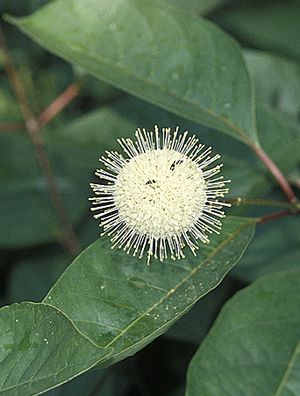« Previous Plant | Next Plant »
Cephalanthus occidentalis
Buttonbush
Cephalanthus occidentalis, Buttonbush, is one of the most important native shrubs for helping to preserve water quality and for enhancing wildlife habitat. The extensive fibrous root system of Buttonbush pulls nutrients out of water and the water's edge. Buttonbush usually grows on banks, partly in water, but can grow in moist areas. It is an excellent choice for helping to reduce erosion. Butterflies and nectar-feeding insects are attracted to the two-inch diameter, spherical white blooms. Other insects feed on the foliage and often become fish food on windy days! (Fisherman have learned to cast near Buttonbush overhangs). The shrubs provide nesting areas for birds and shelter for many animals.
- » Erosion control
- » Unique flowers
- » Pollinator plant

A lover of wetland habitats, Cephalanthus occidentalis propagates readily along waterways from layering and or seed. They are good for erosion control and are at home in floodplain forests, shrubby swamps, and wet thickets. Their unique bright white, spherical blooms occur in late June to early July and attract numerous pollinators in search of nectar. Cephalanthus occidentalis is a host plant for titan sphinx moths and hydrangea sphinx moth caterpillars. They grow 6’-15’ tall, with an irregular but arching habit. Buttonbush also makes a beautiful ornamental addition to any wetland garden. Either way, Cephalanthus occidentalis is an excellent plant to have around for all its ecological services!